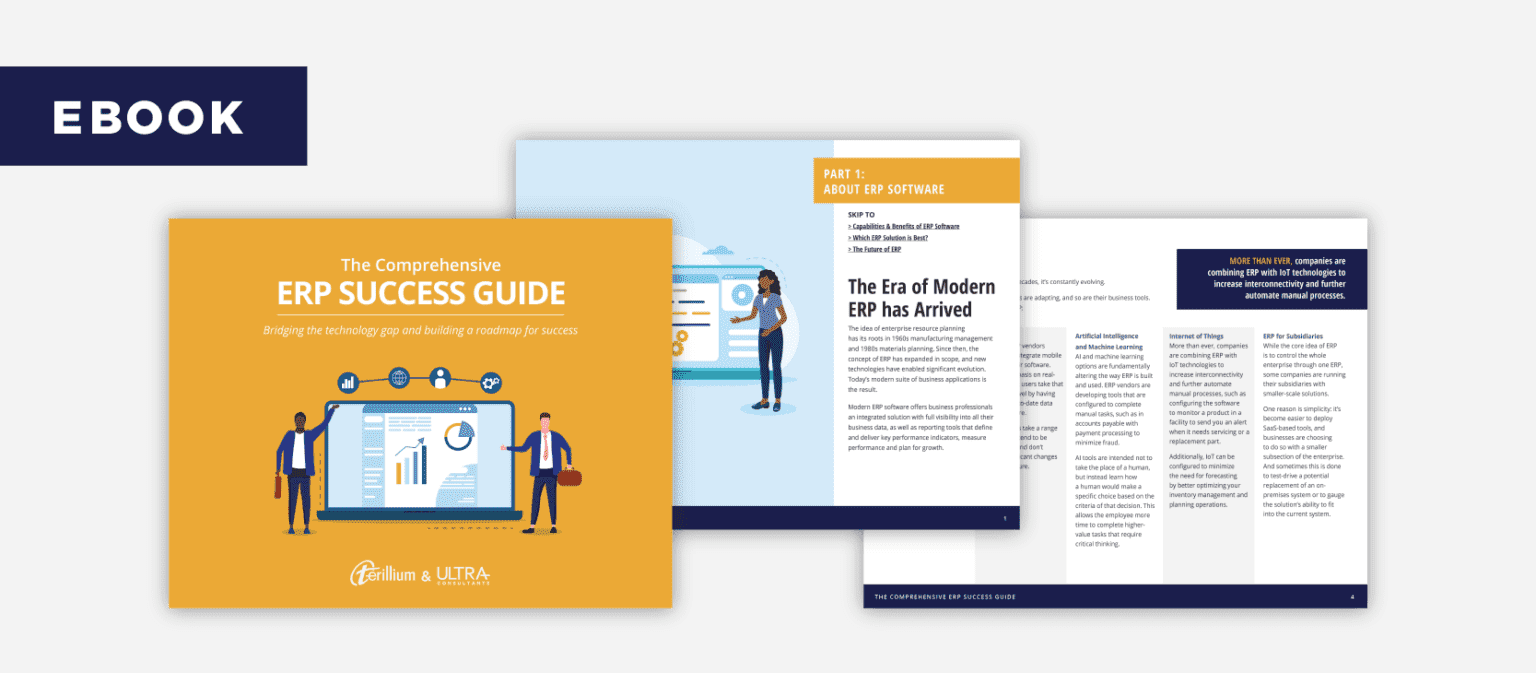What’s the deal with ERP and change management? In our experience as an independent ERP consultant team, an ERP selection and implementation initiative is only successful with an understanding that the process is much more than just swapping out legacy software or tweaking a few IT solutions. It’s crystal clear that an ERP implementation is a change management initiative.

The Comprehensive ERP Success Guide
The Comprehensive Success Guide will give you the knowledge you need to ensure your new solution achieves your business goals.
Ultra makes the case that change management is not just a phase. Instead, change management must be woven into the fabric of evaluation, selection and implementation methodologies, built into the project plan and team culture throughout every phase of a technology project.
It’s key to be continuously aware of change promoters, adopters, influencers, and resistors as they transition from current to the future state.
Four Lessons Learned
As an example of findings from academic researchers who have studied change management and ERP, past analysis by Swedish researchers shows that ERP methodologies are not one-size-fits-all approaches.
The researchers studied a major electronics manufacturer with ten globally distributed organizations “led by their own kings within their own kingdoms, some with their own agendas.”
To align processes with corporate objectives, the global manufacturer’s leadership team decided to centralize the organization’s processes by implementing an ERP application.
The study noted that the project was a success because of the emphasis on change management, with the following leadership transformation lessons from the implementation:
- Learn from the past: Glean insights from past efforts at reorganization and IT implementation. It’s tempting to put a failed project behind the organization, instead take the time to do a “post mortem” that looks at what the causes were related to the failed ERP implementation.
- Consider interdependencies: Anticipate a dynamic interaction between changes in the organization and the IT system. An enterprise technology project might entail interdependencies that cut across each area of the business, such as finance, accounting and supply chain, to shop floor, production, inventory, quality management, shipping and more.
- Gather enterprise-wide input: Manage change so that local conditions determine the appropriate timetable for implementation. A “top down” approach when it comes to standardizing on enterprise systems rarely succeeds. Pull input from all the impacted organizations to fully understand needs and project goals, which helps minimize resistance and drives user adoption.
- Listen: Learn to listen to the concerns and ideas of the people affected by the reorganization. Here again, be concerned about how the work force will react to a new ERP system. For a transformation to be successful, the people component is the most critical piece for project success.

ERP and Change Management: Additional Best Practices to Consider
As is clear from the lessons learned above, when it comes to change management and ERP, the emphasis must be on people and processes along with technology. Success follows from a structured, purposeful approach aimed to help transition people, teams, and organizations from their current state to the desired future state.
Researchers add to the four “lessons learned” above, offering the following implications to put into practice during ERP project management:
- Treat ongoing failures during the change as an opportunity for learning and foster an organizational culture that supports it.
- Be open for discussion and reflection and don’t be afraid to alter strategic direction during the change journey.
- Repurpose technological and organizational-based learning from the past experiences.
- Treat IT projects as part of an on-going program requiring continuous improvement.
- Match the approach to change the design to the levels of experience, stages of learning and different activities of each unit.
- Allocate at least 50 percent of the budget of an IT project to organizational aspects of the change such as developing new processes, roles, routines, communication, education, and training.
- Put change management on top the executive agenda and develop tools, roles, methods and skills for its execution.
- Make sure that the leaders that act as change agents and transformation managers excel at listening and communication.
Change Management and ERP – Additional Reading
Ultra is regularly called upon to address issues related to change management and ERP.
As an example, the industry publication ERP Focus shared insights from Rich Sides, Ultra’s COO, about change management as related to real-world enterprise technology initiatives.
Considering how your ERP project will impact change at your company? Contact the Ultra team for further insight.






